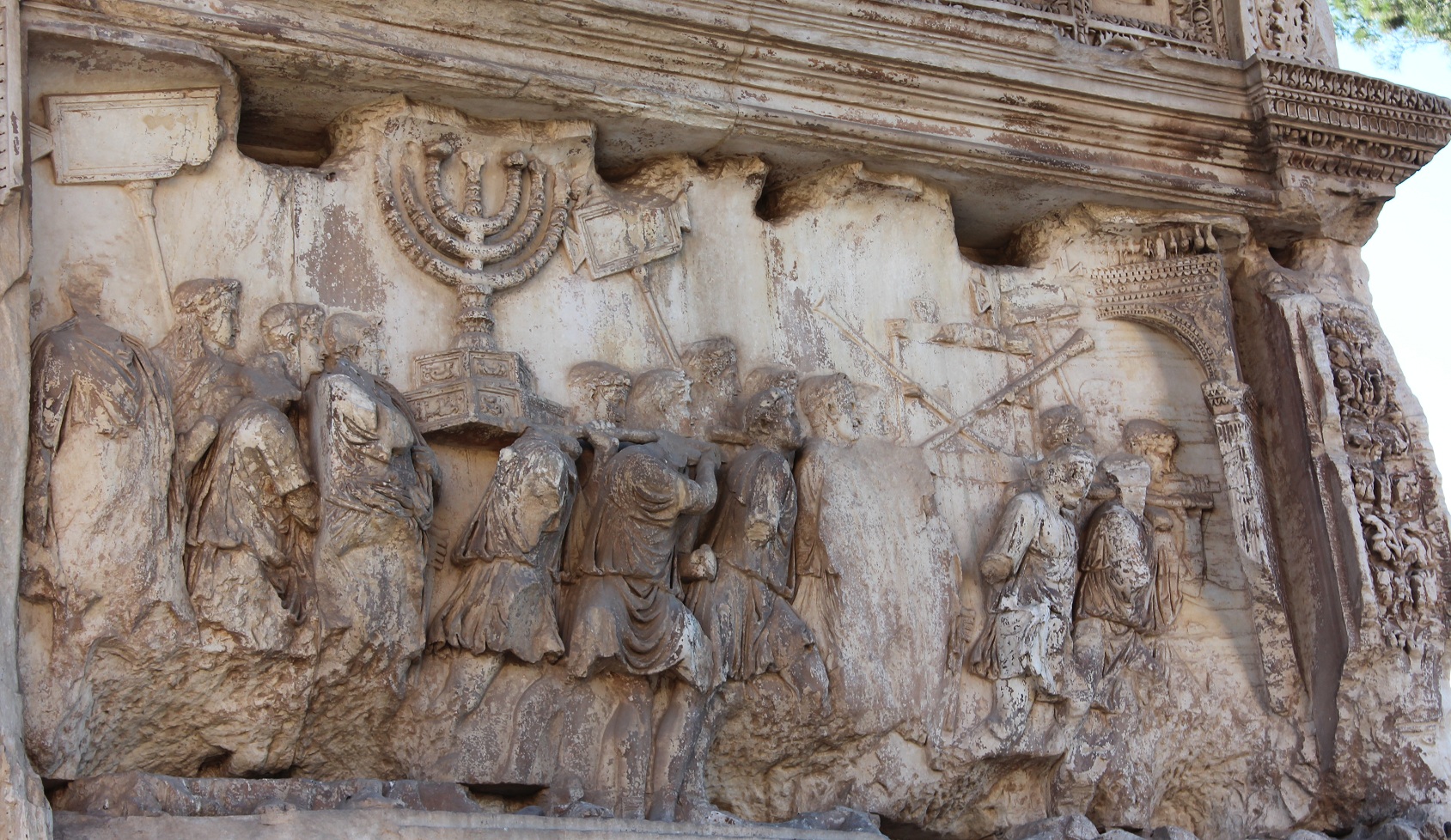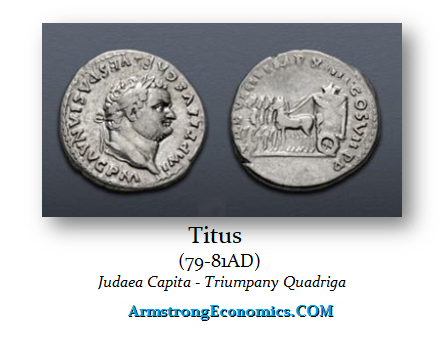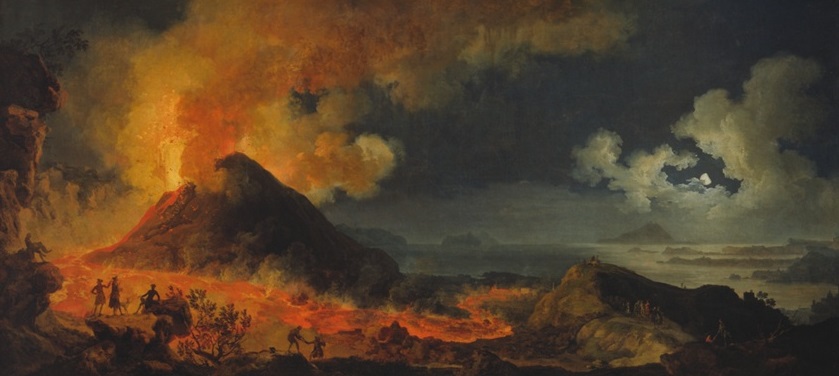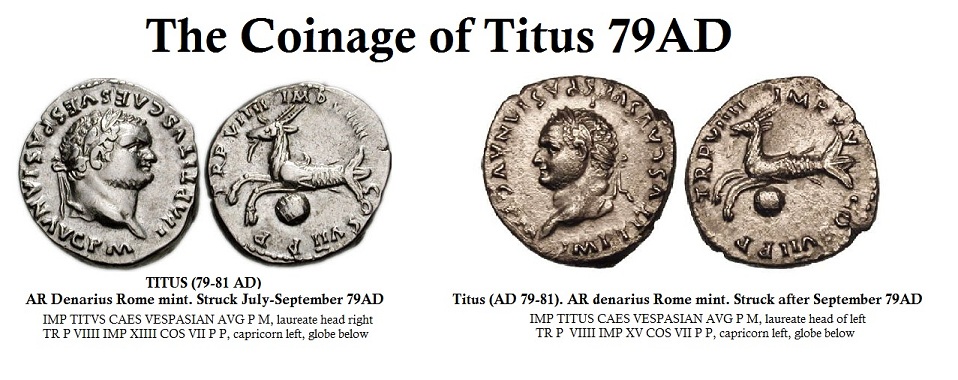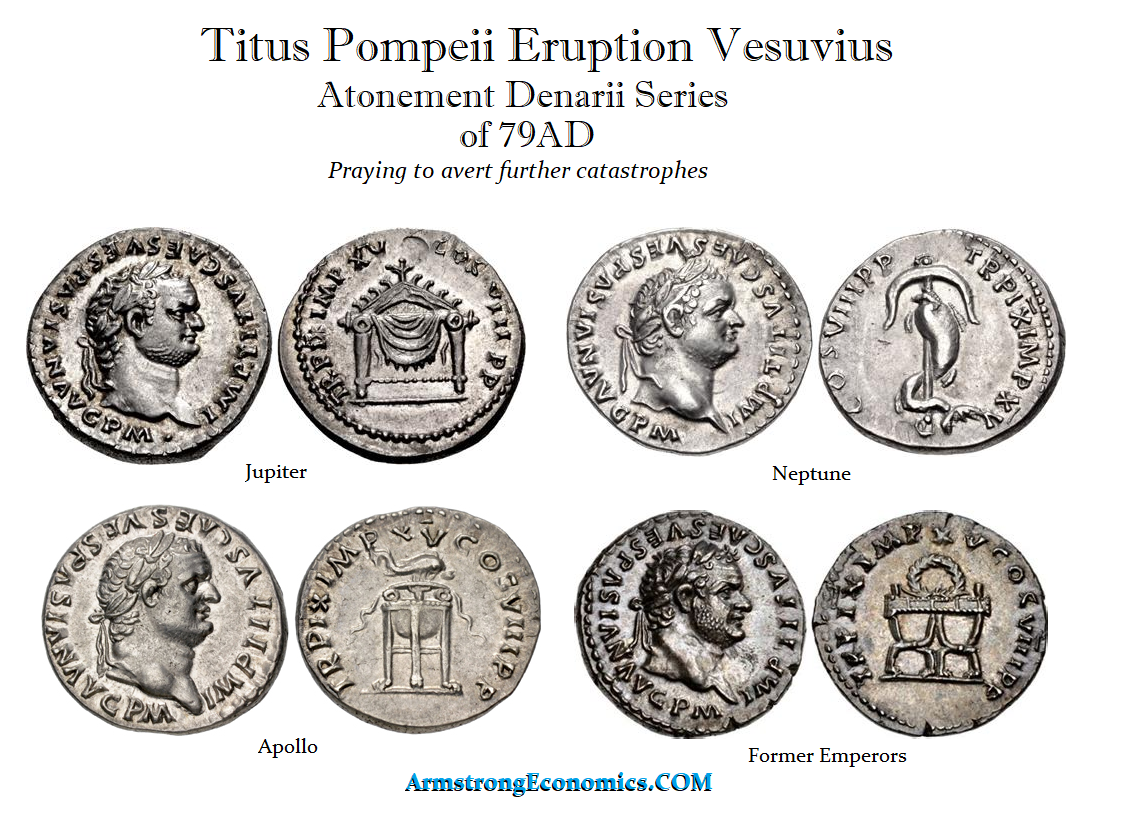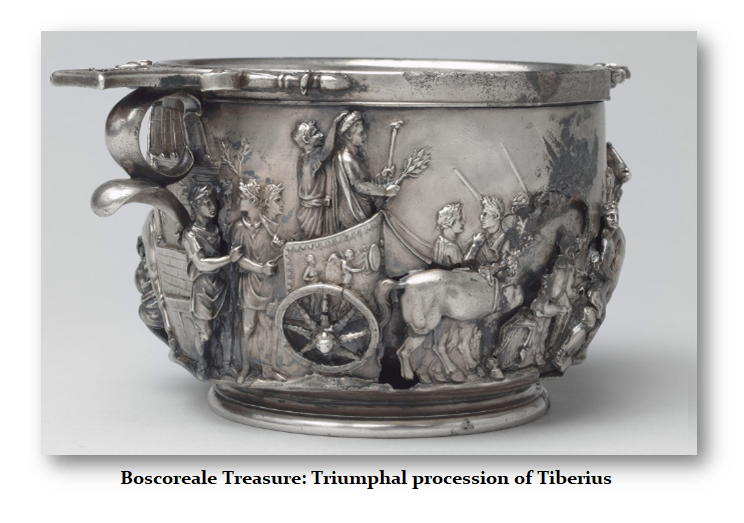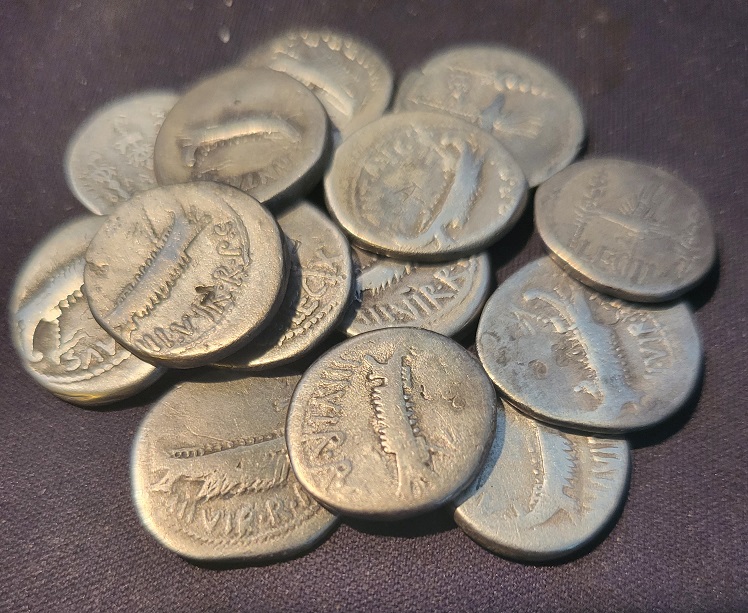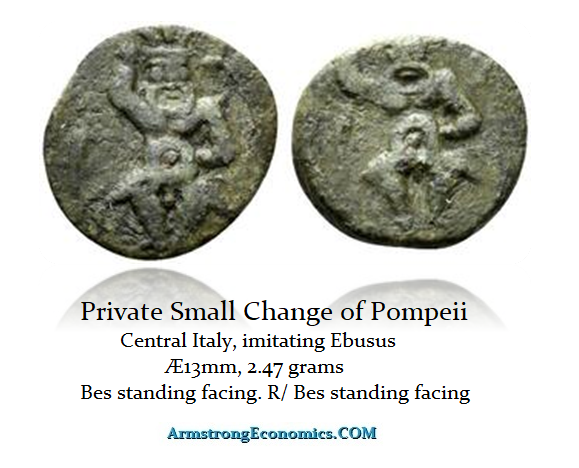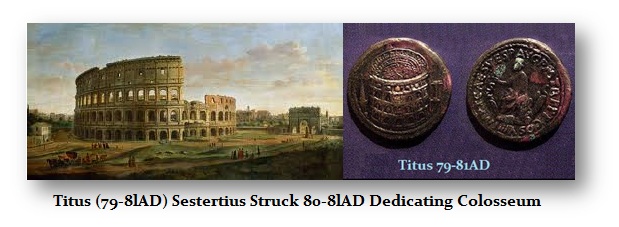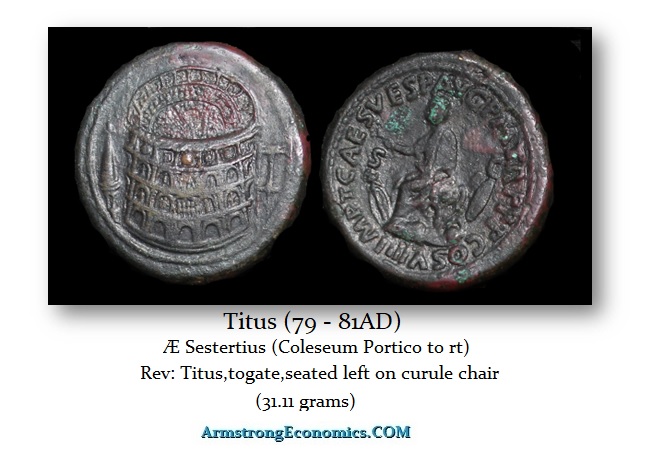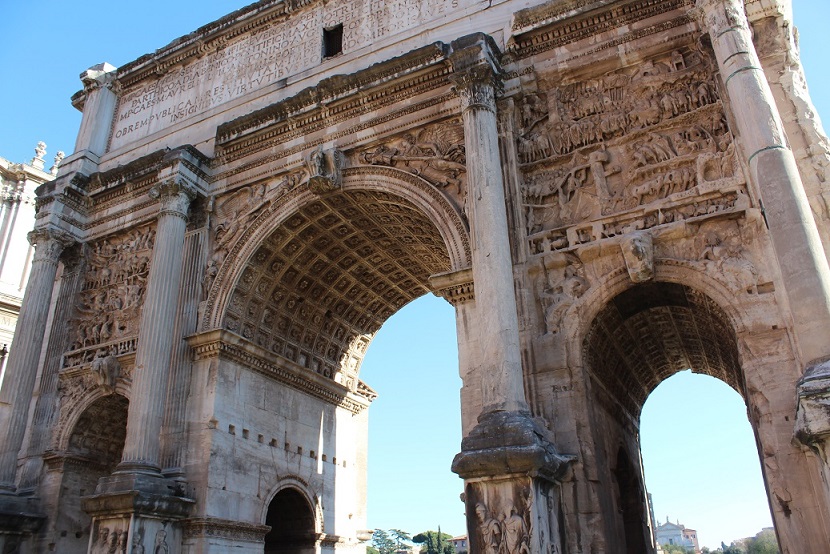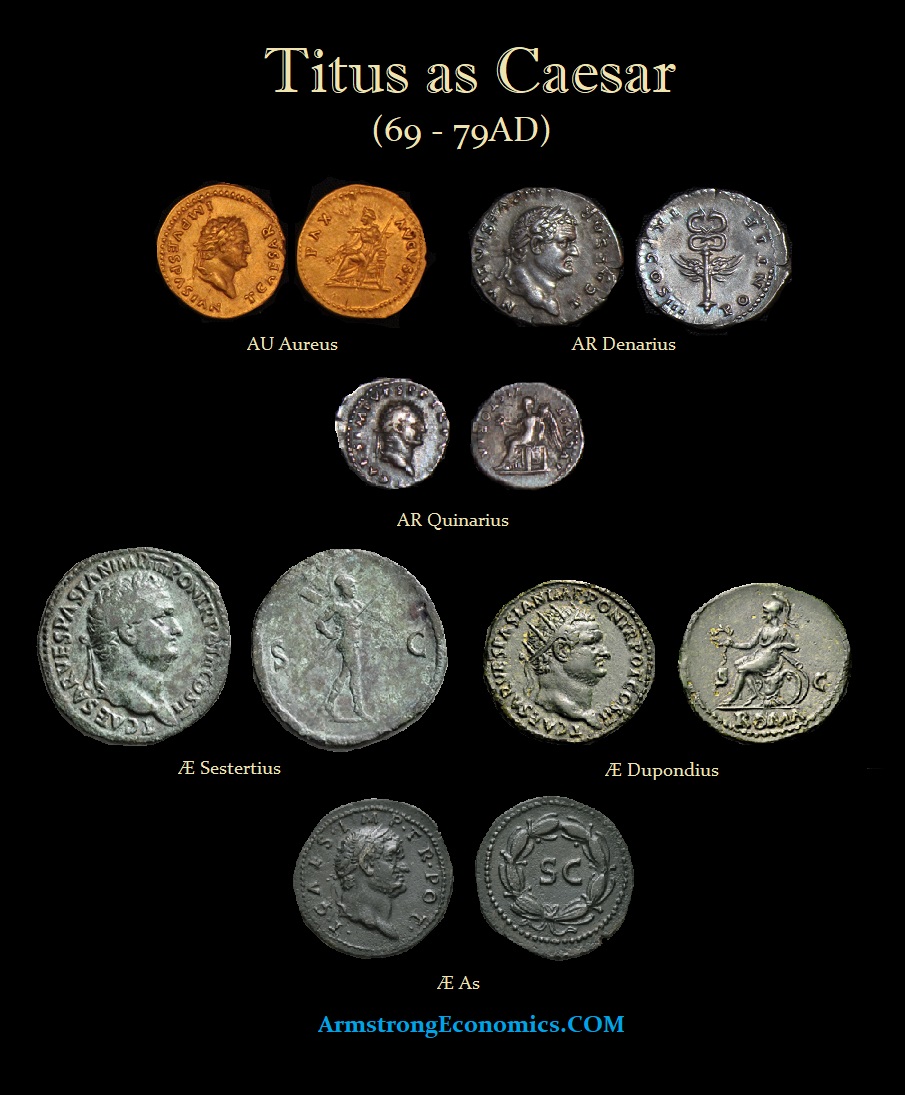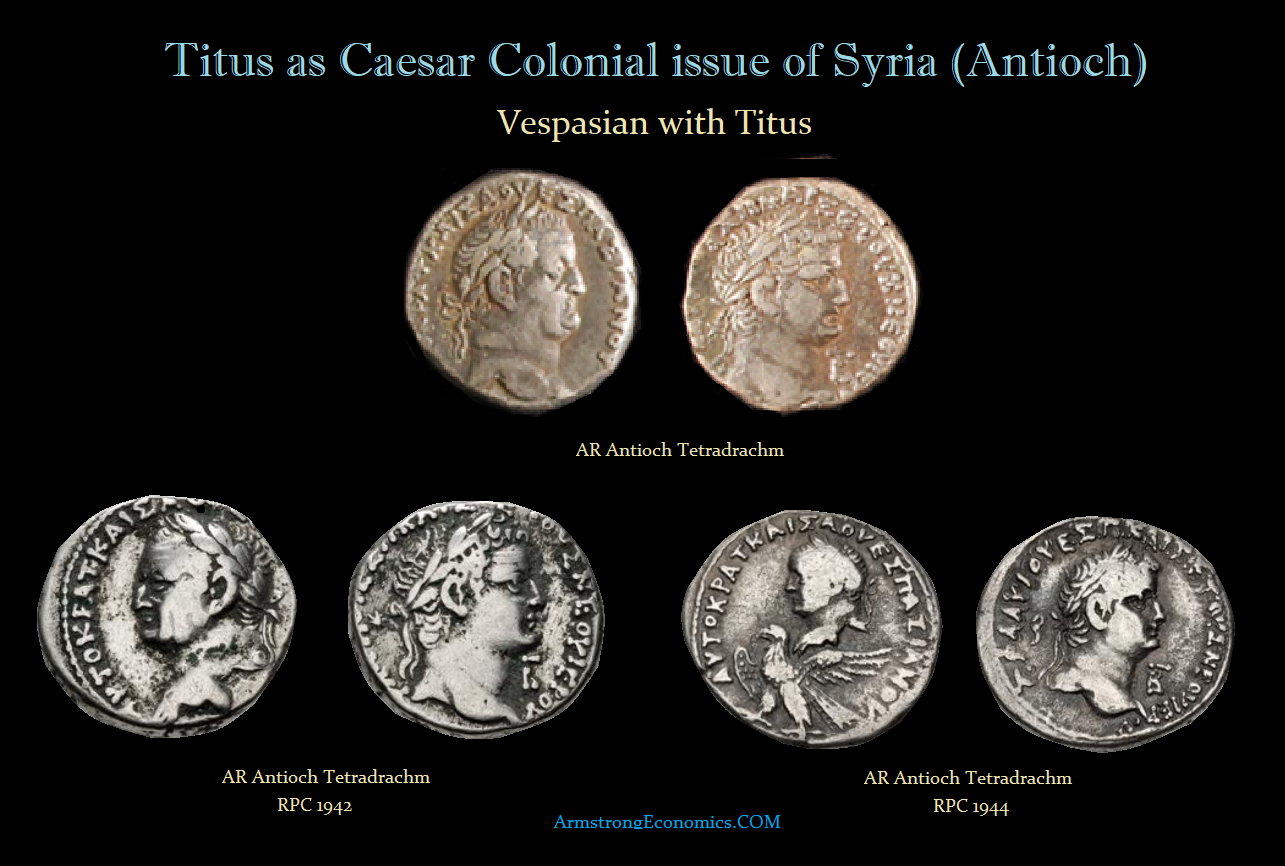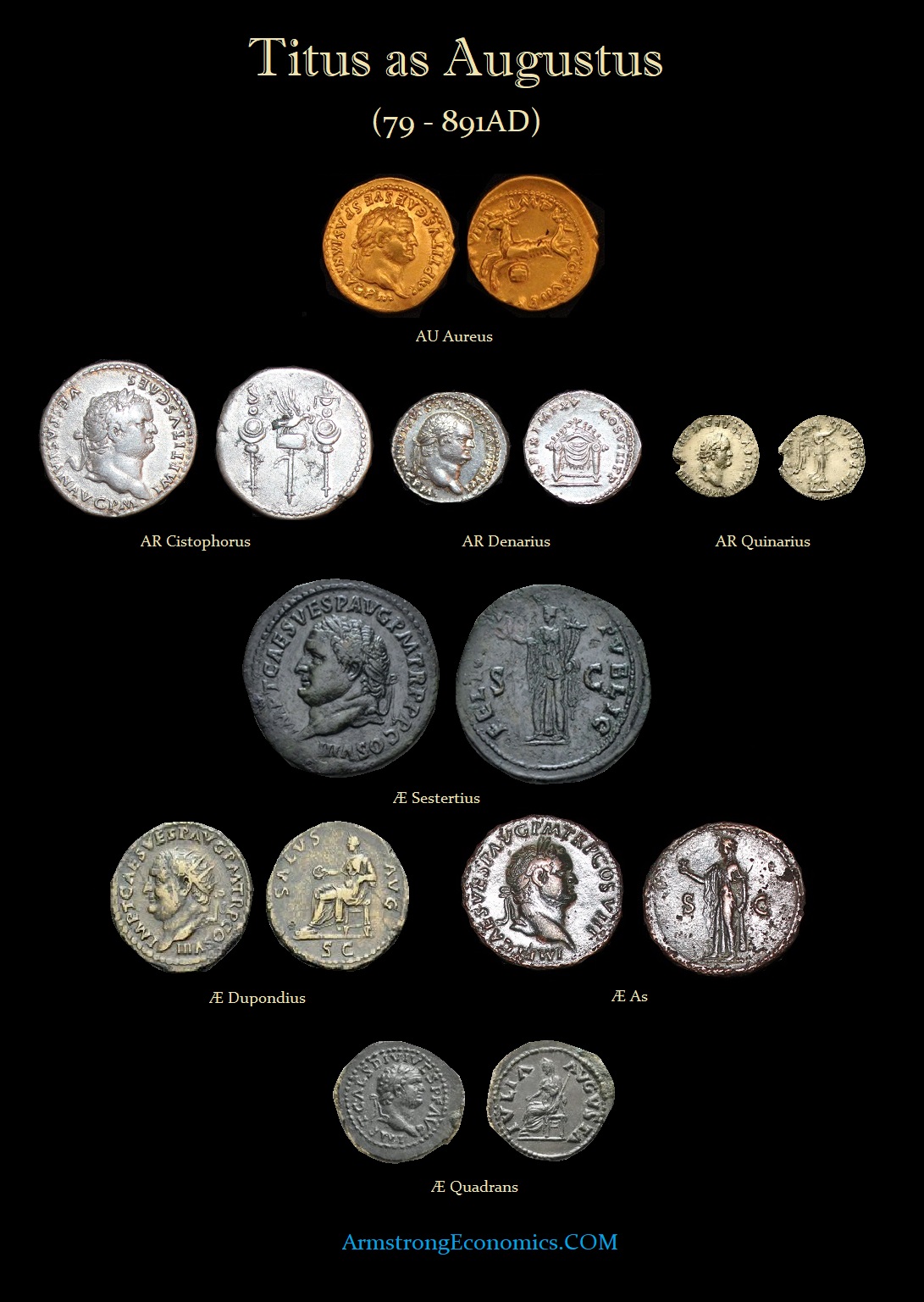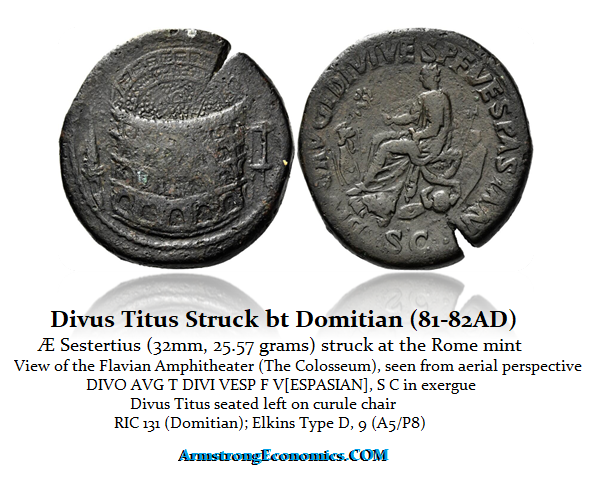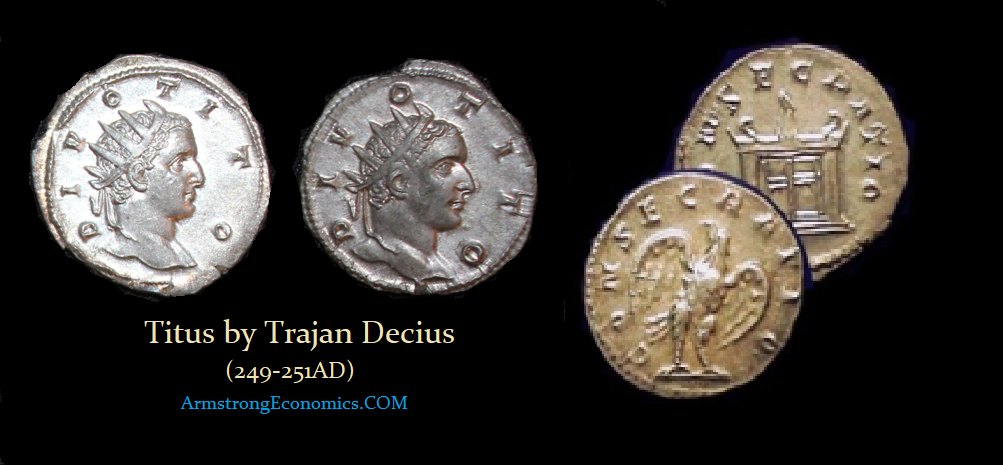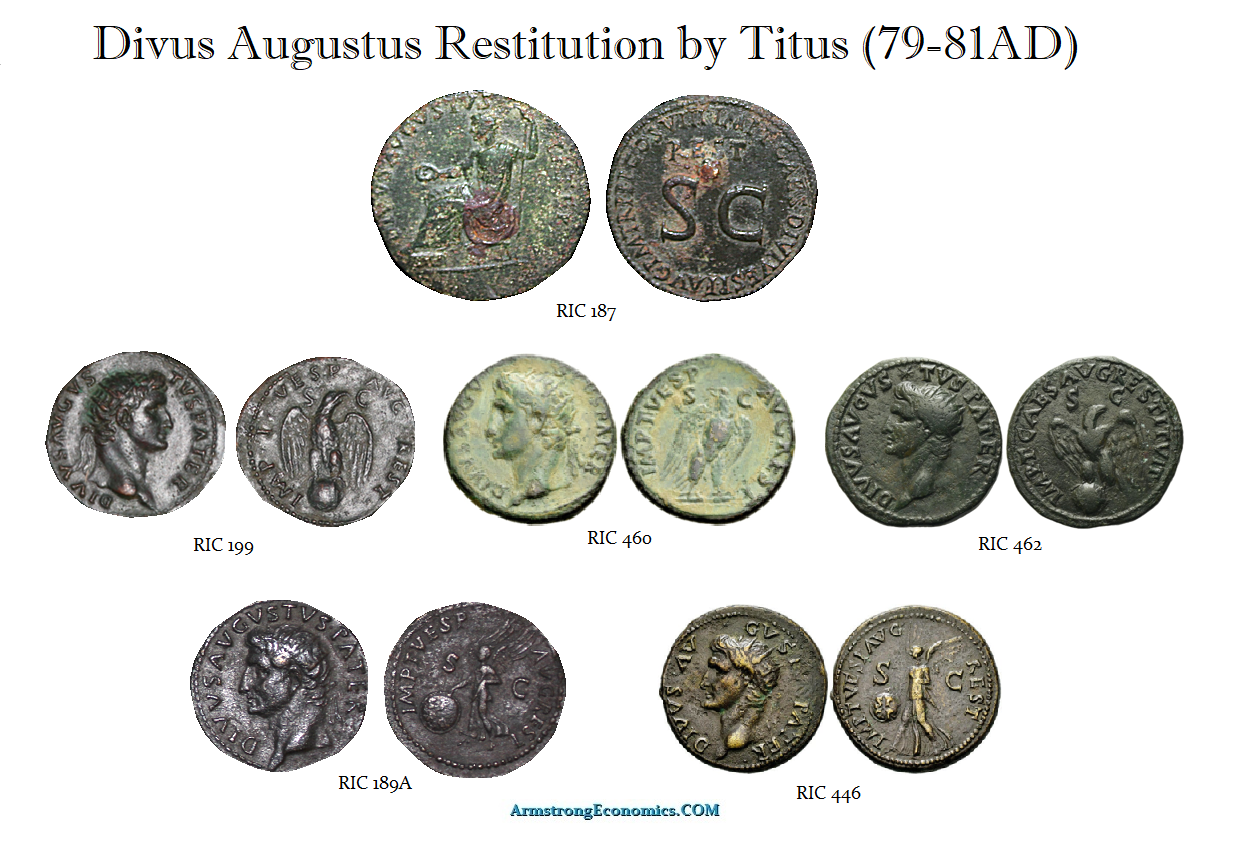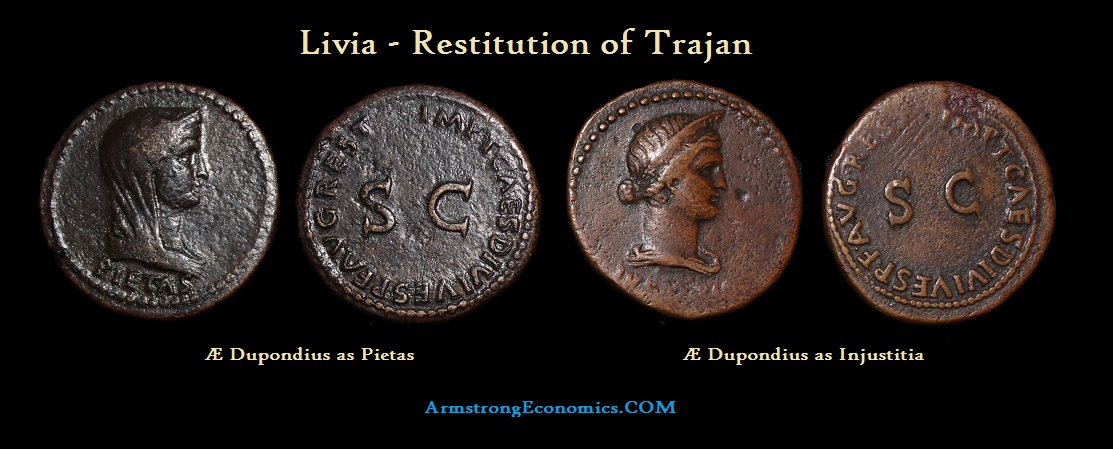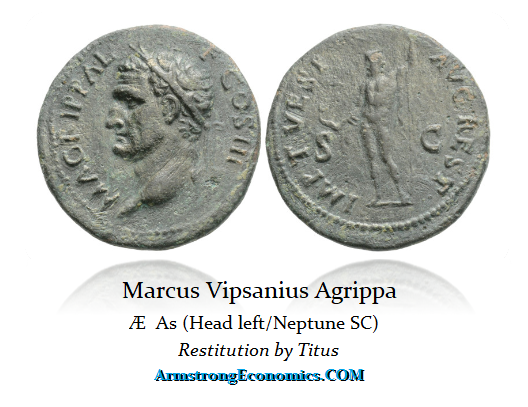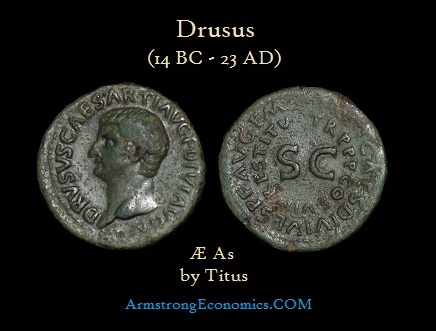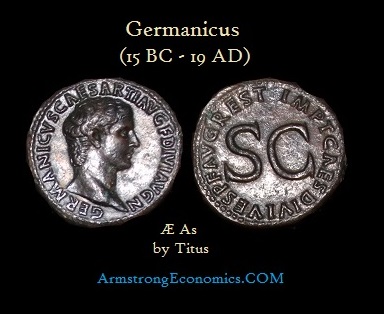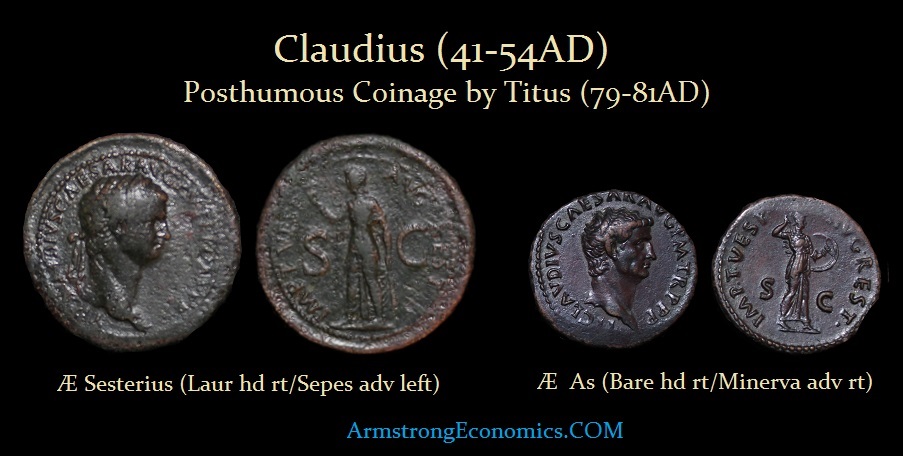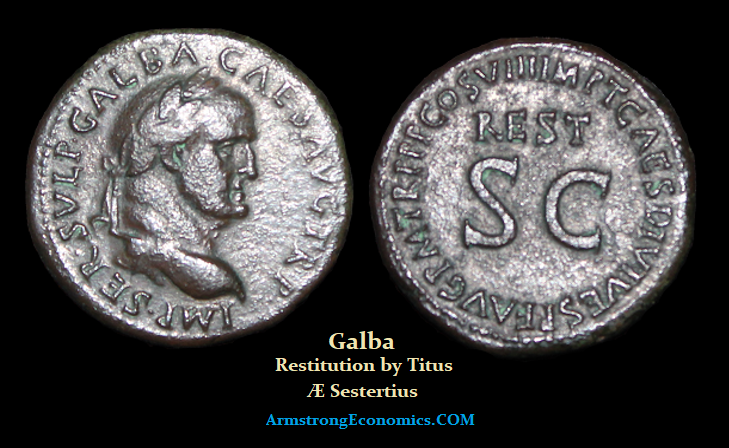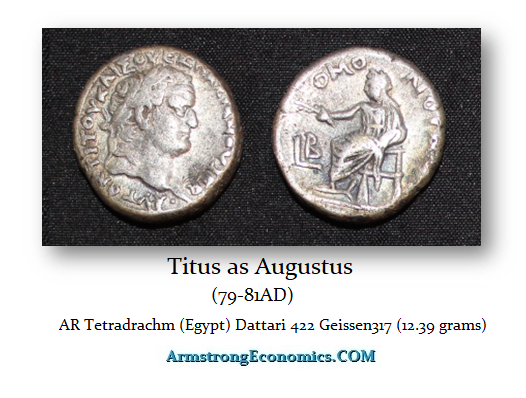Titus

Emperor, 79 – 81 AD
Born 41 – Died 81 AD, Age 40
Titus Flavius Vespasianus Junior was the elder son of Vespasian and Flavia Domitilla. Titus was born in Rome on December 30th, 39 AD. Vespasian had served under Claudius in his conquest of Britain with distinction and honor. His reward was to allow his son Titus to be educated at court. Thus, Titus and Britannicus, Claudius’ ill-fated son, were educated, and the two became good friends.
Titus began his career as a military tribune in Germany and Britain between 61 and 63 AD. Titus then returned to Rome, where he married Arrecina Tertulla, the daughter of the former commander of the Praetorian Guard. Unfortunately, his bride died within a year of their marriage. Titus remarried once again, but this time, he chose someone of higher birth – Marcia Furnilla. This second marriage also briefly lasted since his wife’s family was closely linked to Nero’s opposition. After the attempted poisoning of Nero in 65 AD, Titus divorced his wife. Nonetheless, Titus did father a daughter with Marcia named Julia Titi, who would later become the mistress of Titus’ brother Domitian.
Between 66 and 70 AD, Titus’ career took a turn. He was appointed commander of the 15th Legion and served in his father’s Jewish campaign. At this time, Titus grew closer to his father, Vespasian, and became a trusted agent.
Titus’s Triumphant Arch in the Roman Forum showing the Sack of the Jewish Temple in 70AD
In the chaos of the Civil War that emerged following the death of Nero, Titus began to support his father’s cause after the murder of Galba. Titus gathered support from several governors to back his father’s bid for power. When his father, Vespasian, was proclaimed Emperor on July 1st, 69 AD, Titus was raised to the rank of Caesar. When his father left to become Emperor, Titus remained to carry on the war and captured Jerusalem in 70 AD. After the fall of Jerusalem, Titus gave orders to his legion commanders to kill every male Jew in the province to prevent any further uprisings in the future.
On his return to Rome in June of 71 AD, Titus was given a splendid reception, and his father made him his colleague in the government. Titus shared the reigns of power, and the historian Suetonius described him as his father’s partner and protector. Titus assumed command of the Praetorian Guard no doubt to perform the role of protector given the treachery that they had expressed toward Galba. Suetonius tells us that there was another reason for Titus’ appointment to the Guard. He used his power to convict any and all political opponents, who often resorted to forgery—this period under his father won Titus the reputation of being cruel and ruthless.
His father, Vespasian, died of natural causes, so to speak. He went to Campania and visited a natural spring called Aquae Cutiliae. After drinking the water, he contracted some sort of bacteria, which led to almost constant diarrhea. On June 23rd, 79 AD, Vespasian finally stood on his feet and, with those immortal words, “An emperor ought to die standing,” collapsed into the arms of his attendants.
Thus, Titus succeeded his father on that day. Based on his reputation, many expected Titus to become another Nero. Much to their surprise, Titus’ nature was transformed. He became one of the most caring and generous Emperors of Rome.
August 24, 79 AD, The Eruption of Mount Vesuvius
In October 79AD, not on August 24, 79 AD as so many thought, Mount Vesuvius erupted, burying alive residents of both Pompeii and Herculaneum. Titus, like a good head of state, immediately organized a disaster relief effort and traveled to visit the site personally on two occasions. Pompeii has been perhaps the most important relic from the past, yielding untold insight into the everyday lifestyle of Rome at this point in history.
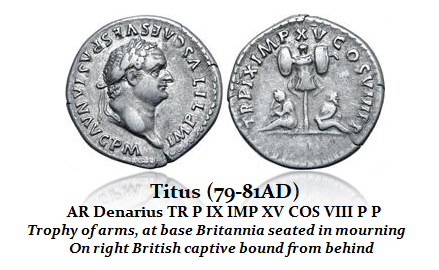 A single silver denarius of Titus was discovered in 1974 among the 180 silver coins buried in Pompeii. When it was cataloged, it overturned history. Titus’ father died on June 24th, 79 AD. Therefore, any coin of Titus as emperor would have to be the very first recording of his power, “IMP VI” or 6th Imperator, a title that meant ‘leader of the army’ to the Romans. The coin discovered in Pompeii had the legend “IMP XV,” which was granted to Titus for the war in Britannia.
A single silver denarius of Titus was discovered in 1974 among the 180 silver coins buried in Pompeii. When it was cataloged, it overturned history. Titus’ father died on June 24th, 79 AD. Therefore, any coin of Titus as emperor would have to be the very first recording of his power, “IMP VI” or 6th Imperator, a title that meant ‘leader of the army’ to the Romans. The coin discovered in Pompeii had the legend “IMP XV,” which was granted to Titus for the war in Britannia.
Titus sent Gnaeus Julius Agricola, who pushed further into Caledonia and established several forts there, as the historian Tacitus recorded (Agricola 22). Therefore, Titus received the title of Imperator for the fifteenth time for this event, according to Cassius Dio (Roman History LXVI.20). This took place in September 79 AD, about three months after becoming emperor following his father’s death. Obviously, if any coin was discovered in the ruins of Pompeii with “IMP XV” in its legend, then this provides absolute proof that the date for Vesuvius of August 24th, 79 AD cannot be correct.
Archeologists in Pompeii have discovered a remarkable inscription written in charcoal, which has survived the catastrophe. This confirms that the eruption of Mt Vesuvius took place in October 79AD, as confirmed by the coin that was discovered and ignored by historians. The charcoal writing, discovered on the wall of a villa during a new phase of excavations, adds weight to a theory that the volcano destroyed the town in October 79AD rather than August of that year in line with Cassio Dio and the denarius of Titus. The date of August 24th, 79 AD, came from a letter addressed by Pliny the Younger to the Roman historian Tacitus, originally written some 25 years after the event.
Titus devoted much of his silver coinage of Atonement to the gods for the disaster of Pompeii. There were four main Atonement issues commemorating the services of prayer and propitiation through which the emperor attempted to address the public alarm over the disaster. People often attributed such events to the gods being angry. The coinage showed emblems seeking the approval of Jupiter, Neptune, Apollo, and the deceased former Emperors to watch over the Roman people.
News spread rapidly around the Roman Empire. There were formal boards where notices would be posted in which important news and major events would be informed to the people much like such a board in a big company with notices to the employees. These boards called the Acta Diurna, and were designed to inform the Roman people, thereby avoiding fake news. We could call them ancient billboards in modern terms, and even government officials would walk up and pin a written notice, and the crowds would rush to see what is news. Thus, everyone knew of Pompeii in a matter of days. It did not take long for information to circulate.

One villa, Boscoreale, has yielded splendid works of art and is one of the largest hoards of Roman gold coins to date. The gold coins have a distinctive dark colorization from the sheer heat of the eruption. Perhaps this is the most famous discovery from Pompeii, known as the Boscoreale Treasure. This discovery came to light in 1895, when the treasure was uncovered among volcanic ash from the eruption of Mount Vesuvius in October 79 AD.
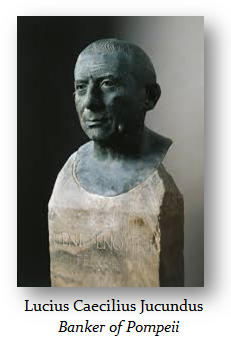 The precious metal objects from the Boscoreale Treasure were illegally exported from Italy. Baron Edmond de Rothschild (1845-1934) purchased them on the black market and donated them to the Louvre Museum in 1896. It appears that the objects were deliberately hidden in the storehouse before the eruption of Mt. Vesuvius. The name written on many of the containers was Maxima. A woman was found dead in the ruins, but we do not know if she was Maxima or a servant who stayed behind. The villa appears to have been owned by Maxima’s father, L. Caecilius Jucundus, a banker from Pompeii. This one hoard was a substantial cash reserve of the banker. That makes sense, given the vast wealth in coins discovered. He also seems to have inherited the wealth of the Julio-Claudian dynasty in Campania. Jucundus had a villa in Pompeii as well, and his banking records show that he survived. Here is a recreation of his villa as it looked before the eruption.
The precious metal objects from the Boscoreale Treasure were illegally exported from Italy. Baron Edmond de Rothschild (1845-1934) purchased them on the black market and donated them to the Louvre Museum in 1896. It appears that the objects were deliberately hidden in the storehouse before the eruption of Mt. Vesuvius. The name written on many of the containers was Maxima. A woman was found dead in the ruins, but we do not know if she was Maxima or a servant who stayed behind. The villa appears to have been owned by Maxima’s father, L. Caecilius Jucundus, a banker from Pompeii. This one hoard was a substantial cash reserve of the banker. That makes sense, given the vast wealth in coins discovered. He also seems to have inherited the wealth of the Julio-Claudian dynasty in Campania. Jucundus had a villa in Pompeii as well, and his banking records show that he survived. Here is a recreation of his villa as it looked before the eruption.
In 1895, excavations at a Roman villa at Boscoreale on the slopes of Vesuvius unearthed a remarkable hoard of coins, 109 items of silverware, and over 1,000 gold aurei, the latest of which dates to 78 AD with many pieces dating back decades prior, such as the gold aureus of Nero (54-68 AD). The villa that held the coins was undisturbed until 1876, yet the coin hoard lay undiscovered for almost another 30 years. The original owner hid the treasure in a wine tank before the eruption, so it was not immediately discovered.
The Boscoreale treasure included a remarkable set of tableware reflecting the quality of Roman silverwork in the 1st century AD. Here, we have a spectacular cup with Tiberius’s triumphant procession. This is simply an amazing artistic work from the 1st century AD.

The decoration on these two cups illustrates a most curious theme. Epicurean maxims (engraved in dots) and the skeletons of poets and Greek philosophers represent an invitation to enjoy the present, for death comes to us all.
What is further enlightening from the excavation of Pompeii is the Economic history that has been revealed through coins. The most common coin found was that of the Legionary Denarii of Mark Antony at the Battle of Actium, funded by Cleopatra. She funded the Civil War of Antony against Octavian for the Dynasty of Alexander the Great to conquer Rome and place her son on the throne – Caesarion; she had with Julius Caesar. The WOKE revision of history claiming Cleopatra was black is just laughable.
Most curious is the discovery of large quantities of coins from cities in the western Mediterranean, particularly Ebusus and Massalia. Alongside these were locally or regionally produced imitations of these coins, typically displaying the god Bes and another with a butting bull. While this sheds light on the commercial ties of Pompeii and the Bay of Naples region, it also demonstrates the lack of small change, which explains the numerous private quadrans issued from the period of Domitian through Antoninus Pius over the following 100 years.
Unfortunately, Pompeii was not the only disaster that befell Rome during Titus’s reign. The City of Rome was hit by another devastating fire, which consumed most of the area between the Capitol and Agrippa’s Pantheon. To make matters worse, a severe epidemic struck the populace. At every turn, Titus was there to support and help the people, and as such, his reputation as Emperor was transformed from Titus to Caesar.
Colosseum
Titus completed the construction of the Colosseum, started by his father, partially as a gift to the city begun initially to compensate for Nero’s excesses. However, the Colosseum was also partly to commemorate his victory over the Jews and the sacking of Jerusalem. Additionally, the construction of the Colosseum in the aftermath of the destruction of Pompeii was to boost morale and confidence, just as the construction of the Empire State Building in New York City during the Great Depression.
The only military conquest during his short two-year, two-month, and twenty-day reign was the expansion of Roman territory in Britain. The Romans were pushing northward in an attempt to conquer Scotland. Although there was some progress, the conquest of Scotland was never accomplished, and the effort was finally abandoned under Hadrian (117-138 AD), who erected the famous wall that bears his name.
Titus died on September 13, 81 AD, at the age of 42. His death appears to have been of natural causes, although Suetonius reported a rumor that his brother Domitian tried to help his brother die a bit sooner by packing him in a chest of ice to bring down a fever. Titus’s last words have also survived: “I have made but one mistake.” Nobody knows what that mistake was, and there is certainly little shortage of speculation.
Titus was deified immediately by his brother Domitian. The Senate erected the Arch of Titus, which still stands today in the forum. The inscription on the Arch reads… “From the Senate and people of Rome to the deified Titus Vespasianus Augustus, son of the deified Vespasian.”
Monetary System

AU Gold Aureus of Titus as Caesar
discovered in the Boscoreale Hoard at Pompeii
Mints: Rome, Lugdunum, Ephesus
Obverse Legends: as Caesar 69-79 AD
T CAES IMP
T CAESAR IMP VESPASIAN
T CAESAR VESPASIANVS
T CAES VESPASIAN IMP P TR P COS II
T CAES VESPASIAN IMP P TR P COS II
T CAES IMP PON TR P COS II CENS
T CAES VESPASIAN IMP PON TR POT COS III CENS
T CAESAR IMP COS III CENS
T CAESAR IMP COS IIII
T CAES IMP AVG F TR P COS VI CENSOR
Obverse Legends: as Augustus 79-81 AD
IMP TITVS CAES VESPASIAN AVG P M
IMP T CAES VESP AVG P M TR P COS VIII
IMP T CAES VESP AVG P M TR P P P COS VIII
IMP T CAESAR VESPASIANVS AVG
IMP T VESP AVG COS VIII
Note: Gold coinage as Augustus is much rarer than as Caesar

AR Silver Denarius of Titus
DENOMINATIONS
As Caesar under Vespasian
AU Aureus (7.23 grams)
AU Quinarius
AR Denarius (3.42 grams)
AR Quinarius (1.51 grams)
AE Sestertius
AE Dupondius (12.6 grams)
AE As (10.59 grams)
AE Semis
Colonial as Caesar
ANTIOCH, Syria
AR Tetradrachm Antioch (WITH VESPASIAN)
AR Tetradrachm Antioch (WITH VESPASIAN hd left)
AR Tetradrachm Antioch (WITH VESPASIAN hd left with eagle)
As Augustus
AU Aureus (7.23 grams)
AU Quinarius
AR Cistophorus (11.32 grams)
AR Denarius (3.42 grams)
AR Quinarius (1.51 grams)
AE Sestertius
AE Dupondius (12.6 grams)
AE As (10.59 grams)
AE Quadrans
Posthumus Coinage
AE Sestertius (Colessuem) by Domitian
AR Antoninianus by Trajan Decius (249-251AD)
NOTE: This is the only posthumous coinage issued after the death of
Restoration of Titus (COMMEMORATIVES)
DIVVS AUGUSTUS
Æ Sestertius (Aug seated lf/SC)
Æ Dupondius (Rad Hd Lf/Vic adv left)
Æ Dupondius (Rad Hd Lf star above/Vic adv left)
Æ Dupondius (Rad Hd rt/Vic adv left)
Æ As (Rad hd left/Altar)
Æ As (Rad hd left/Altar)
Æ As (Rad hd left star above/Altar)
Æ As (Rad hd left/Eagle on a globe)
Æ As (Rad hd rt/Eagle on a globe)
Æ As (Rad hd left/Eagle on thunderbolt)
Æ As (Rad hd Rt/Eagle on thunderbolt)
Æ As (Rad hd left/Eagle on cippus)
LIVIA
Æ Dupondius (IVSTITA)
Æ Dupondius (Pietas)
MARCUS AGRIPPA
Æ As (by Titus REV: IMP T VESP.. )
TIBERIUS
Æ Sestertius (Divvs Tiberius seated by Titus)
Æ As (Bare hd left/SC) by Titus
Æ As (Bare hd rt/SC) by Titus
Æ As (Bare hd rt/Winged Caduceus) by Titus
DRUSUS
Æ As (by Titus)
NERO CLAUDIUS DRUSUS
Æ Sestertius (Bare hd left/SC)by Titus
GERMANICUS
Æ As (by Titus) hd rt / SC
Æ As (by Titus) hd Left / SC
AGRIPPINA I
Æ Sestertius (SC by Titus)
CLAUDIUS
Æ Sestertius (Laur hd Left/Sepes adv lf)
Æ Sestertius (Laur hd rt/Sepes adv lf)
Æ Dupondius (Bare hd rt/Cerces Seated left)
Æ As (Bare hd rt/Constantia stg lf)
Æ As (Bare hd rt/Minerva adv rt)
Æ As (Bare hd Left/Minerva adv rt)
GALBA
Æ Sestertius (Laur hd rt/SC)
Æ Dupondius (Laur hd rt/SC)
Æ As (Laur hd rt/Libertas stg left)
Æ As (Laur hd rt/Pax stg left)
COLONIAL (as Augustus)
CAESAREA
AR Hemidrachm (CÆsarea) Greek legends
ANTIOCH, Syria
AR Tetradrachm (Egypt)
EGYPT
AR Tetradrachm (Egypt)

